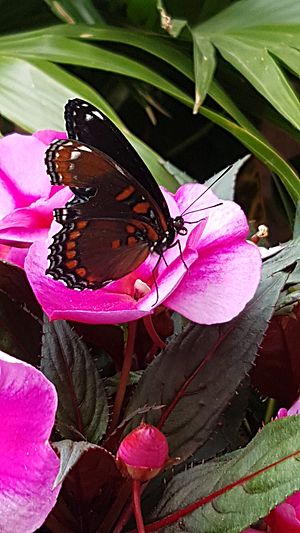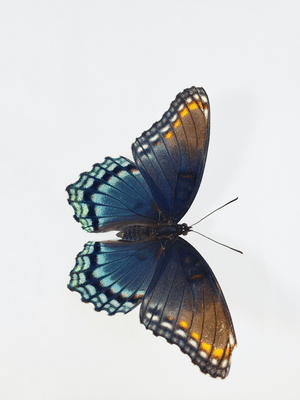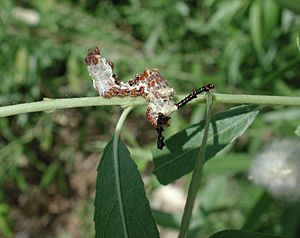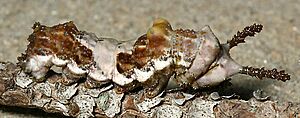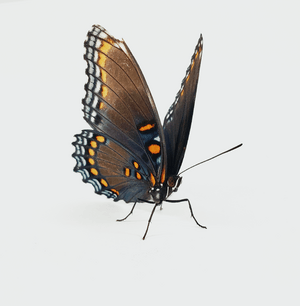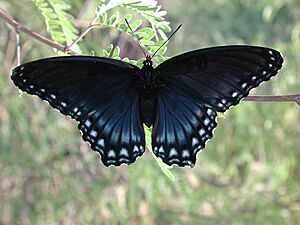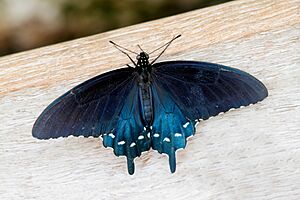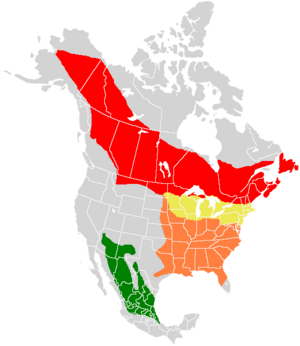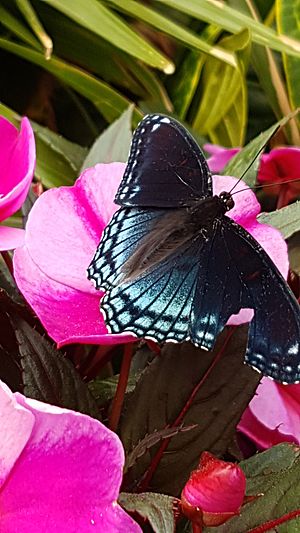White admiral facts for kids
Quick facts for kids White admiral |
|
|---|---|
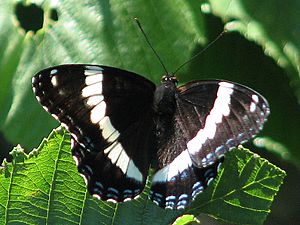 |
|
| L. a. arthemis | |
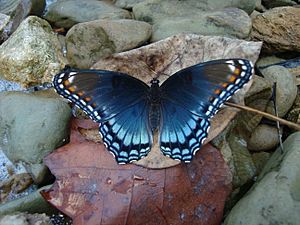 |
|
| L. a. astyanax | |
| Conservation status | |
| Scientific classification | |
| Synonyms | |
|
Basilarchia arthemis |
The Limenitis arthemis is a beautiful North American butterfly. It's often called the red-spotted purple or white admiral. Scientists study this butterfly because it's a great example of how animals can evolve to look like other animals (this is called mimicry). It also shows how different types of the same butterfly can mix together.
This butterfly comes in two main types. The northern type, called the white admiral, has a clear white band across its wings. The southern type, called the red-spotted purple, does not have this white band. Instead, it looks like the pipevine swallowtail, which is a butterfly that tastes bad to predators. Because these two types live in some of the same areas, they often mate and have mixed offspring.
Contents
About the White Admiral Butterfly
The Limenitis arthemis is a very active butterfly. It flies close to the ground, usually only about 2 to 3 feet high. When it's not flying, it's always moving around on leaves and folding its wings. These butterflies love the sun and often rest on the highest parts of trees. When they rest, they keep their wings closed and their bodies angled upwards.
Male and female Limenitis arthemis butterflies look almost the same. However, females are usually a bit bigger than males.
White Admiral Appearance
The white admiral (L. a. arthemis) is mostly blackish-blue on its upper side. It has wide white bands across both its front and back wings. Some white admirals also have a row of red spots near the edge of their wings, while others have blue spots there. The underside of their wings is blackish with a wide white band. The part of the wing closest to the body has many red spots. The outer edges might have red or bluish spots.
Red-Spotted Purple Appearance
The red-spotted purple (L. a. astyanax) looks a lot like the white admiral, but it doesn't have the wide white bands. Its front wings sometimes have a row of red spots near the edge. The back wings are a shiny blue or bluish-green. The underside of its wings also lacks the white band. It has several red spots near the body and a row of red and bluish spots near the edges.
Where They Live
Limenitis arthemis butterflies live all over North America. The white admiral (L. a. arthemis) lives in the northern parts, from New England and the Great Lakes area up into Canada. The red-spotted purple (L. a. astyanax) lives further south. The area where both types live and often mix is in New England and around the Great Lakes. These butterflies like to live in deciduous forests, especially along the shady edges of the woods and roadsides.
Male Butterfly Behavior
Male Limenitis arthemis butterflies are very protective of their space when they are looking for a mate. They try to defend areas where many female butterflies visit. When another male comes close, they will often fight. These fights usually last a few minutes. After a fight, the male will patrol his area to make sure no other males try to take over. They tend to stay loyal to their chosen territory.
What They Eat
Caterpillar Food
Caterpillars in the areas where the two types of butterflies mix often eat trees from the willow family, like aspen, poplar, and willow trees. Caterpillars in the northern regions mostly eat yellow birch trees. Southern caterpillars prefer black cherry trees and other plants from the rose family.
Adult Food
Adult butterflies usually eat rotting fruit and nectar from small white flowers.
Life Cycle
Limenitis arthemis butterflies usually have two generations each year, from April to October. Most caterpillars from the first generation grow to be half-size. Then, they build a special shelter called a hibernaculum and sleep through the winter. They wake up in the spring. Some caterpillars grow faster and become butterflies in the summer, forming a second generation in early fall. These second-generation butterflies also mate and lay eggs. However, their caterpillars often don't grow enough to hibernate, which can be dangerous for them.
Egg Stage
The eggs are grey-green and last about 7 days. They have a unique kite-shaped pattern on them.
Caterpillar Stage
After hatching, the caterpillars live for a few weeks. They have wood-brown heads and bodies that are dark brown with yellow borders. Older caterpillars are deep brownish-olive with faint white sections on their backs. Their legs are reddish-brown. Caterpillars that are in their third stage of growth will hibernate for the winter.
Pupa Stage
The pupa stage, also called a chrysalis, lasts about 10–14 days. The chrysalis can be creamy white or silvery grey.
Adult Stage
Adult butterflies from the first generation usually start flying by mid-June. They are diurnal, meaning they fly from morning until just after sunset. An adult butterfly lives for about 4 months.
How They Protect Themselves
Batesian Mimicry
The red-spotted purple butterfly (L. arthemis astyanax) is a great example of Batesian mimicry. This means a harmless animal looks like a dangerous or bad-tasting one to trick predators. The red-spotted purple butterfly looks like the pipevine swallowtail, which predators learn to avoid because it tastes bad. Both butterflies have dark wings with shiny blue on their back wings.
The white admiral (L. arthemis arthemis) is the non-mimic form. It has a bright white band on its upper wings, which the red-spotted purple lacks.
Scientists have found that a specific gene called WntA might be responsible for how the red-spotted purple butterfly developed its mimicry. This gene is important in the early growth of many animals.
Butterfly Types
There are several types (subspecies) of Limenitis arthemis:
- Limenitis arthemis arthemis: This is the American white admiral, with the white band on its wings.
- Limenitis arthemis astyanax: This is the western American white admiral, also known as the red-spotted purple, which lacks the white band.
- Limenitis arthemis rubrofasciata: This type has a brick-red band along the edges of its lower back wings. They are mostly found west of Lake Superior.
- Limenitis arthemis arizonensis: This red-spotted purple or red-spotted admiral looks similar to L. a. astyanax but has pointier back wings. It lives in the southwestern United States.
Mixing of Types
The Limenitis arthemis is a great example of different types of the same species mixing together. The two main types that mix are the white admiral (L. a. arthemis) and the red-spotted purple (L. a. astyanax). This mixing happens in a narrow area across New England, southern Ontario, and the Great Lakes. This area is sometimes called a "suture region."
Scientists believe these mixing zones formed when two different groups of butterflies, which were already genetically distinct, met and started to interbreed. It's also common for L. arthemis to mate with other similar butterfly species, like L. archippus.
Reproduction
Male Mating Behavior
Male butterflies look for places where many females visit. They usually start looking for mates in the afternoon, between 11 am and 4 pm. Most males will perch (sit) to defend their territory. They don't usually perch on the trees where caterpillars eat. Instead, they sit on other plants like maple, elm, or raspberry bushes, usually about 1–2 meters (3–6 feet) off the ground. This might seem strange because females often look for mates near food sources. So, males might be defending areas that don't attract the most females.
Male-Male Interactions
Males often act aggressively towards each other when fighting over territory. These fights can be about a female that is just emerging from her chrysalis or about owning a good breeding ground. These fights are important because female butterflies can mate with more than one male. This means males compete to be the father of the offspring. Fights usually involve circling flights, vertical or horizontal chases, and hovering. The "loser" is often chased away from the area. These fights help males find the best mates.
Female-Male Interactions
When a female butterfly lands on a leaf, the male will land behind her very quickly. If the female does not want to mate, she will close her upper wings.
Ecology
Limenitis arthemis caterpillars prefer to eat the leaves of certain plants. These include:
- birch trees, like Betula lenta
- Willow family plants (Salicaceae), like Salix bebbiana and Populus tremuloides
- Prunus virginiana (from the rose family)
They also sometimes eat:
- Crataegus
- Amelanchier
- Malus pumila
- Prunus pensylvanica and Prunus serotina (rose family)
- Populus deltoides, P. grandidentata and P. balsamifera (willow family)
- Alnus rugosa, Betula alleghaniensis and Carpinus caroliniana (birch family)
- Ulmus americana (elm family)
- Tilia americana (mallow family)
- Fagus grandifolia (beech family)
Name Origin
The name Limenitis comes from New Latin, meaning "of harbours." It comes from an Ancient Greek word that was a nickname for Artemis, the goddess of the hunt and the wild. The species name arthemis also comes from Artemis.
Images for kids



